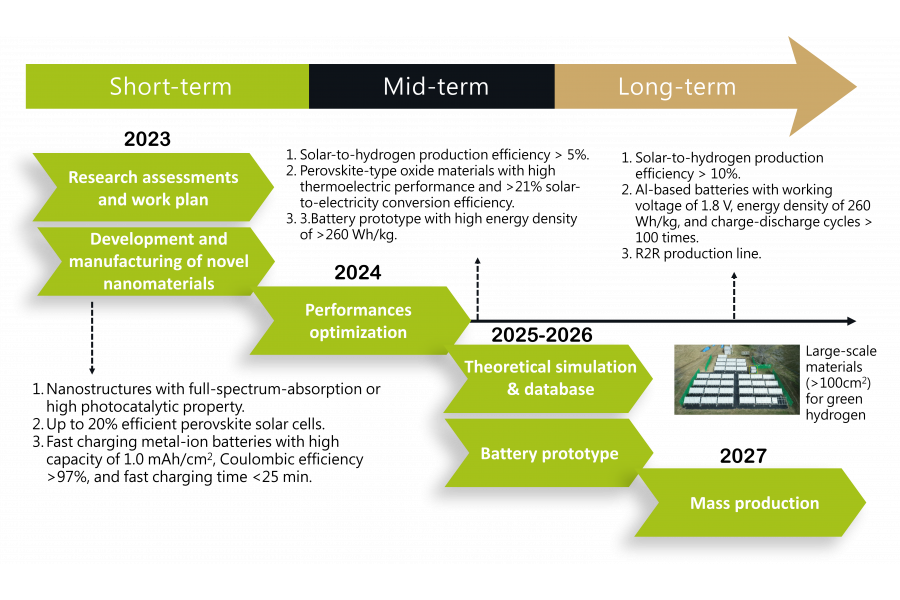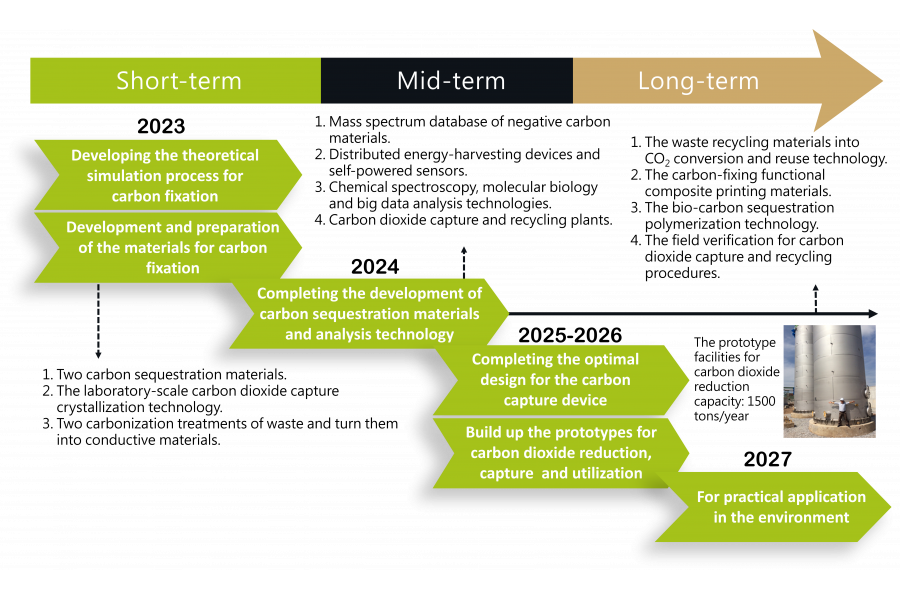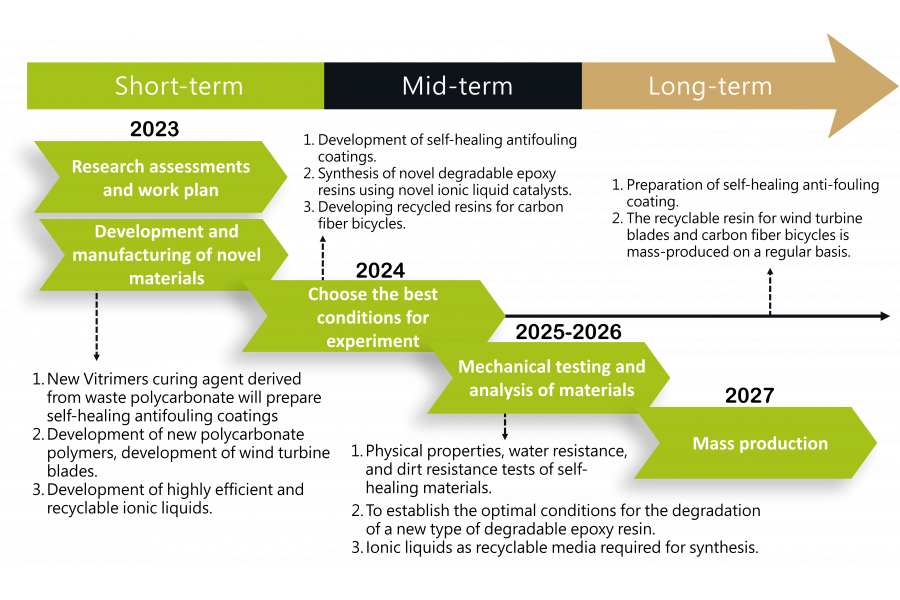Clean energy
Energy breakthrough and manufacturing新能源突破與製造
The project also advances in the expansion of metal-ion energy storage battery systems to achieve the goal of rapid charging and energy storage. This core project provides a comprehensive system from emerging energy generation to storage, making a visionary contribution to the goal of global net-zero emissions by 2050.
PIProf. Kuan-Jiuh Lin
MemberProf. Hong-Ta Yang, Prof. Heng-Jui Liu, Prof. Te-Hsien Wang, Prof. Chieh-Ting Lin
Emphasize developing full-spectrum semiconductor functional materials for applications in photocatalytic water splitting to produce hydrogen. In the research of photovoltaic energy conversion, the main focus is on optimizing and developing various energy conversion techniques and components.
PIProf. Meng-Chang Lin
MemberProf. Ping-Yu Chen, Prof.Si-Yu Li, Prof. Wen-Yin Ko
Aiming at the development of high-performance metal-ion batteries and related materials, incorporating high-capacity and fast-charging metal oxide anodes for the preparation of fast-charging lithium-ion battery energy storage systems. This project aims to advance technologies reserved for the ′post-lithium era′ and plans on developing low-cost, high-safety aluminum-ion batteries, which can reduce the battery′s dependence on rare elements like lithium. These batteries also ensure that the assembled energy storage systems do not pose safety risks such as combustion or explosion.
Sustainable cloud computing platform永續雲平台
PIVP & Prof. Yin-Tzer Shih
MemberProf. Hung-Hsu Tsai, Prof. Chih-En Kuo
Three research highlights:
(1) The establishment of the “Agricultural Carbon Inventory Database and Trading Cloud Platform” involves creating a cloud-based platform for carbon inventory to support data storage and management for various projects of iSNR. This achieves the goal of integrating data across different projects.
(2) ′Big Data Analysis and Optimization Technology for Carbon Inventory (Carbon Emissions, Carbon Sinks, Carbon Credits, Carbon Trading, and Carbon Neutrality),′ entails developing big data analysis and optimization techniques related to carbon inventory. It offers solutions for carbon offsetting and provides incentive feedback mechanisms, encouraging high-carbon-emitting businesses to use the platform.
(3) ′Development of Carbon-Negative Agricultural and Livestock Industry Scientific Measurement Methodology′ focuses on defining various sustainable carbon-negative indicators and measurement methods.
PIProf. Lo-Yao Yeh
MemberProf. Iuon-Chang Lin, Dr. Jen-Wei Hu
Three research highlights:
(1) The establishment of “Blockchain infrastructure” and the initial construction of blockchain-based “Carbon Credit Certificate” and “Verification Functionality.”
(2) The functionality of the ′Carbon Credit Certificate Trading Platform′ is to facilitate ′legitimate carbon credit sales′ by sellers through it. The platform is also built on a blockchain to fully realize the core concept of decentralization.
(3) In the field of carbon application, there are certain times when privacies are needed. Since the default setting of blockchain operates on public information, a design of privacy protection is necessary.
Carbon-reduce, reuse and recycle (C-3Rs)
Negative-Carbon Resources負碳材料
PIProf. Ming-Chun Lu
MemberProf. I-Chung Lu, Prof. Chu-Ping Lee, Prof. Yei-Chen Lai, Prof. Ying-Chih Lai
Focusing on utilizing the techniques of material science and engineering, we hope to achieve the goals of carbon reduction, green energy, and sustainability by capturing carbon dioxide and recycling different types of waste materials.
In terms of analysis, the project aims to establish a carbon sequestration analysis platform centered around mass spectrometry and spectroscopy technologies. It will also focus on the mechanisms and reaction kinetics of biological carbon fixation.
The research and development of the related carbon-negative materials is targeted to assist the research areas of animal medicine, smart agriculture, and intelligent healthcare in NCHU.
PIProf. Cheng-Kuan Su
MemberProf. Ping-Shan Lai, Prof. Chiaying Chen, Prof. Kun-Yi Lin
It fully shows the application potential of 4D-Printing that elevates the functionality of carbon-negative materials.
The research and development of the related carbon-negative materials is targeted to assist the research areas of animal medicine, smart agriculture, and intelligent healthcare in NCHU.
Green and sustainable resources永續資源化學
PIProf. Ching-Hsuan Lin
MemberProf. Chih-Feng Huang, Prof. Han-Yu Hsueh
This project involves the development of recyclable wind turbine blades and the utilization of waste polycarbonate-based epoxy resins cured with a catalyst-free solidifier to create multi-scale micro-nano structured surfaces.
The first research highlights synthesizing a series of low-viscosity epoxy resins containing degradable ester or polycarbonate groups for use in recyclable wind turbine blades.
The second research highlights on developing epoxy resins derived from waste polycarbonate and containing siloxane structures. These resins are used as coatings on the surface of nano-porous microspheres and are solidified using a novel Vitrimer solidifier to enhance the adhesion to porous and wrinkled surfaces. This leads to the creation of self-repairing anti-fouling coatings. Through the reuse of waste polycarbonate, the use of catalyst-free epoxy curing agents, and the application of anti-fouling coating materials, we may eventually achieve a circular economy.
PIProf. Chien-Fu Liang
MemberProf. Chien-Fu Liang, Prof. Dong-Sheng Lee, Prof. Shun-Yuan Luo Prof. Cheng-Kun Lin, Prof. Siang-Chen Wu
The research focuses on the carbon deduction process of the energy storage industries and the development and application of carbon-negative high-value green catalysts. It dives into the development of electrode materials for the energy storage industry. Additionally, the carbon dioxide emissions and waste produced during the industrial production process will be used to create high-value cyclic carbonate polymers, polycarbonate polymers, biodegradable polymers, or biochemically synthesized glycine through carbon-negative processes.
In terms of process optimization, the primary research lies in utilizing sodium dithionite and ionic liquids to develop novel green chemical methods and processes. Furthermore, the project aims to develop highly efficient and recyclable ionic liquids to improve the efficiency of traditional organic methods while reducing the usage of organic solvents.





